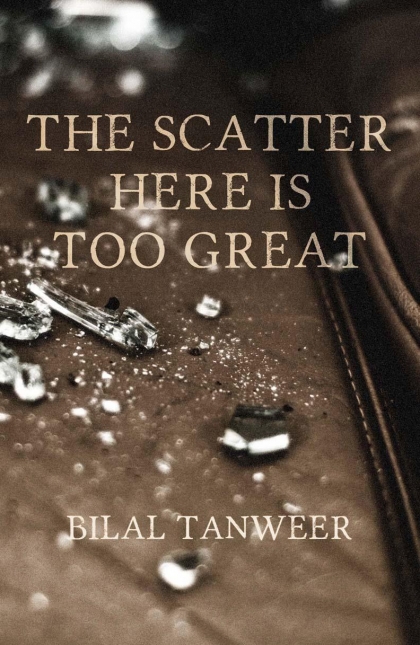The Scatter Here Is Too Great
- By Bilal Tanweer
- HarperCollins
- 208 pp.
- Reviewed by Nathan Blanchard
- August 14, 2014
A debut collection of nine stories tied together by a bombing in Karachi.

Each story focuses on a different character whose life is somehow affected by the blast, but their lives are also interwoven with relationships, families, and the city itself. Through the characters’ shared experiences, Karachi becomes a dynamic and living entity that acts as a megaphone for their dramas.
The characters span several generations and have varying world views. Nonetheless, they are united by several common themes: struggling father/son relationships, the importance of storytelling, and contemplations on modern life in Karachi.
The book orbits several people; among them is Comrade Sukhansaz, an aging Communist poet who is in poor mental health and has an estranged relationship with his son. The narrative quickly shifts to a young man who has stolen his mother’s car to take a girl on a date. This shift is somewhat disorienting, and that disorientation continues throughout the book with each new perspective, but becomes less bothersome as familiar names and places reappear.
We leap to Sukhansaz’s son, who is a successful businessman with an estranged relationship with his own son. The book branches out from Sukhansaz’s lineage and focuses on Sadeq, a young man with a sometimes-illegal job repossessing cars. In one of the book’s highlights, Sadeq’s girlfriend tells her younger brother stories to conceal her inner anguish.
There’s also Akbar, an ambulance driver who attends to the aftermath of the explosion. Interpolated throughout is the story of a writer at three stages of his life: boyhood, adolescence, and adulthood. His changing perspective reflects the changing nature of Karachi.
The structure of the book is a bit…dare I say it, scattered, but clearly this is intended to reflect the book’s central theme. Readers must focus and participate with Tanweer in connecting the characters to one another. He offers little exposition in this regard, and sometimes the connections between narratives are not apparent until later, so readers need to retain details even when they are unsure of their significance at the time.
The stories are not ordered by chronology, nor do they follow one chain of commonality, so some readers might be frustrated with this overly fragmented, out-of-order storytelling. Others may find it energizing and will enjoy making their own connections between the stories, rather than relying upon Tanweer to relate how all the pieces fit together.
This technique of a broken narrative is not new or unusual, but Tanweer seems concerned with telling readers that this is the central point to his characters’ lives, that fragmentation is intrinsic to any meaningful experience of the world. He even comes out and says it, via his characters: “Only fragments were true.” Because of its endless complexity, the world can only be known through pieces: “What appears strange and complex becomes even stranger and more complicated once you begin to investigate it. That’s the true nature of the world.”
Tanweer also suggests, through a father speaking with his son, that being exposed to multiple perspectives is a redemptive way of surviving contemporary life: “‘You see, my son, a city is all about how you look at it,’ he says, looking at me. ‘We must learn to see it in many ways, so that when one of the ways of looking hurts us, we can take refuge in another way of looking. You must always love the city.’”
Tanweer’s knack for crafting distinct voices makes it easier to navigate the fractured plot. The characters tell their tales each with their unique flavors, thereby helping the reader to parse the book into defined storytellers, even when the timeline or orientation to other stories is unknown.
Eventually, the voices seem to coalesce into what feels like the collective voice of Karachi. The descriptions of life in that city sometimes encompass the universal feeling of all modern cities: “Everything around me was shouting — the vendors, the cars’ horns, the rickshaws — even ordinary things hollered. ‘Watch where you’re going!’ The leaning telephone pole yelled at you if you stepped too close to it. Everything could hurt. Insulation was the most important lesson you learned on Karachi’s roads: see as little as possible, hear even less, and touch absolutely nothing. Half the trick to surviving here was to learn to extricate yourself from all the invasive influences around you while keeping a calm appearance. The other half was to emanate some of those influences, so that strangers would stay away.”
The risk in a book like The Scatter Here Is Too Great is that it could be too reductive, that somehow it will simply be a book about Karachi stereotypes, or a book about an explosion, or a book about South Asian life. Again, the narrative is aware of these possibilities and addresses them through the characters: “All these stories, I realized, were lost. Nobody was going to know that part of the city as anything but a place where a bomb went off. The bomb was going to become the story of this city.”
So instead of explaining the cause and purpose of the explosion, instead of reducing the city to one simple blast, these nine stories focus on the lives of those people affected by it, and the aggregate emotions and patterns of meaning that accumulate when scattered lives are gathered together.
The Scatter Here Is Too Great evades oversimplification by offering nuanced characters, rich textures of fragmented experiences, and a distinct writing style. Anyone looking for a linear plotline should steer clear, but they’d be missing out on one hell of a good read.
Nathan Blanchard is an MFA candidate in the creative writing program at the University of Alabama in Tuscaloosa. Hailing from DC and Baltimore, his work has appeared in Atticus Review, District Lines and McSweeney’s Internet Tendency. He enjoys eating at Mexican restaurants with his wife.
